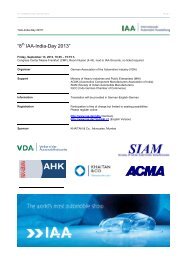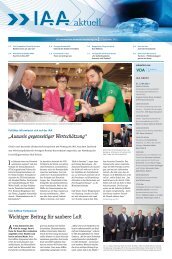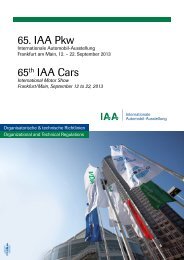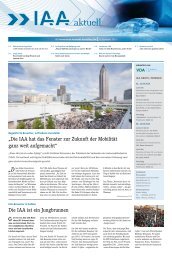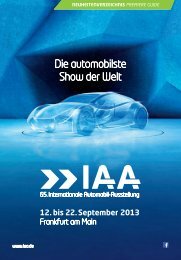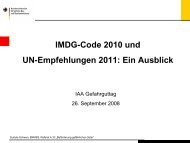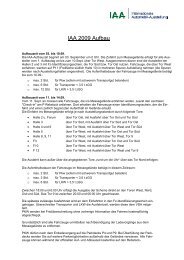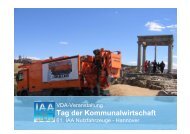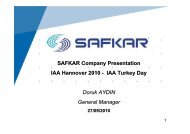Organisatorische und Technische Richtlinien - Archiv - IAA
Organisatorische und Technische Richtlinien - Archiv - IAA
Organisatorische und Technische Richtlinien - Archiv - IAA
Sie wollen auch ein ePaper? Erhöhen Sie die Reichweite Ihrer Titel.
YUMPU macht aus Druck-PDFs automatisch weboptimierte ePaper, die Google liebt.
Alles zum Thema Beleuchtung:<br />
Die Allgemeinbeleuchtung in den Hallen hat eine mittlere<br />
Beleuchtungsstärke von 300 lx, gemessen über dem<br />
Hallenboden.<br />
Sie können auf Ihrem Stand eine zusätzliche Beleuchtung<br />
installieren, um z.B. Ihre Exponate auszuleuchten.<br />
Eine zusätzliche Sicherheitsbeleuchtung auf Ihrem<br />
Stand ist dann erforderlich, wenn Ihr Stand so beschaffen<br />
ist, dass die Sicherheitsbeleuchtung der Halle im Notfall<br />
nicht mehr wirksam ist. Das ist z.B. der Fall, wenn Sie einen<br />
geschlossenen Kabinentrakt planen. In diesem Fall sind Sie<br />
dazu verpflichtet, Ersatzmaßnahmen zu schaffen, die ein<br />
sicheres Zurechtfinden bis zu den Rettungswegen der Halle<br />
gewährleisten. Dazu zählt die Ausleuchtung geschlossener<br />
Kabinentrakte mit einer Minimalstärke von 1 lux/m2 <strong>und</strong><br />
hinterleuchtete Notausgangsschildern.<br />
Eine batteriebetriebene Stromversorgung muss sichergestellt<br />
sein.<br />
Folgendes muss beachtet werden, wenn Sie eine zusätzliche<br />
Beleuchtung zur Allgemeinbeleuchtung der Halle auf<br />
Ihren Messestand einbringen möchten:<br />
– Die Leuchten müssen so beschaffen <strong>und</strong> angebracht<br />
sein, dass Personen, die sich außerhalb der Standfläche<br />
befinden, nicht durch Licht oder Wärme gestört werden<br />
können.<br />
– Die Funktion der Hallensprinkleranlage darf nicht beeinträchtigt<br />
werden; dies gilt als erfüllt, wenn die Lufttemperatur<br />
im Bereich der Leuchten nicht mehr als 60 °C<br />
beträgt.<br />
– Sämtliche Leuchten der Zusatzbeleuchtung müssen über<br />
einen besonderen Schalter ein- <strong>und</strong> ausgeschaltet werden<br />
können.<br />
Ansprechpartner bei der DMAG für Rückfragen zum Thema<br />
Beleuchtung sind die jeweiligen <strong>Technische</strong>n Referenten.<br />
R<strong>und</strong> um die Elektroversorgung in den Hallen<br />
<strong>und</strong> auf dem Freigelände:<br />
Das gilt für Stände in den Hallen <strong>und</strong> auf dem Freigelände:<br />
Die Elektroinstallation auf dem Stand <strong>und</strong> der Anschluss<br />
an das Netz der Messe kann im Service-Angebot bestellt<br />
werden.<br />
Gr<strong>und</strong>sätzlich sind Elektroanschlüsse in allen Hallen <strong>und</strong> im<br />
Freigelände möglich.<br />
Installationsarbeiten auf dem Stand dürfen auch durch<br />
eigene Fachkräfte des Ausstellers unter Beachtung der<br />
gültigen Vorschriften ausgeführt werden.<br />
Anschlüsse an das Versorgungsnetz sowie Verlegungen<br />
von Leitungen außerhalb des Standes <strong>und</strong> in messeeigenen<br />
Kanälen <strong>und</strong> Schächten dürfen nur von dem zugelassenen<br />
Hallenelektriker ausgeführt werden.<br />
Die Inbetriebnahme des Anschlusses erfolgt mit Beginn<br />
der Aufbauzeit. Unmittelbar nach Messeschluss wird mit der<br />
Außerbetriebnahme <strong>und</strong> Demontage begonnen.<br />
Die Versorgung der Stände erfolgt in der Regel aus den<br />
Versorgungskanälen im Hallenboden. Von dort werden die<br />
Leitungen bis zu dem gewünschten Anschlusspunkt gezogen.<br />
Im Stand erfolgt die Leitungsverlegung gr<strong>und</strong>sätzlich über<br />
Flur. Bitte legen Sie daher dem Bestellformular eine Gr<strong>und</strong>risskizze<br />
bei, aus der nicht nur die gewünschte Platzierung<br />
der Anschlüsse ersichtlich ist, sondern auch die Leitungsführung<br />
zu den Anschlüssen.<br />
28<br />
Lighting:<br />
The general lighting in the halls has an average illuminance<br />
of 300 lx, measured above the hall floor.<br />
You can install supplementary lighting on your stand in<br />
order, for example, to illuminate your exhibits.<br />
Additional emergency lighting is required on your stand if<br />
your stand is designed in such a way that the hall’s emergency<br />
lighting is no longer effective in an emergency. This is<br />
the case, for example, if you are planning an enclosed booth<br />
section. In such cases you are required to provide back-up<br />
systems which will guarantee safe navigation to the hall’s<br />
escape routes.<br />
This includes illuminating enclosed booth sections with a<br />
minimum illuminance of 1 lux/m2 and providing illuminated<br />
emergency exit signs. A battery-operated power supply<br />
must be provided.<br />
The following must be noted if you wish to include a supplementary<br />
lighting system on your stand in addition to<br />
the hall’s general lighting system:<br />
– The lights must be designed and mounted such that light<br />
or heat does not impinge on persons outside the stand<br />
area.<br />
– The operation of the hall sprinkler system must not be<br />
impaired; this requirement is regarded as met if the air<br />
temperature in the region of the lights does not exceed<br />
60 °C.<br />
– It must be possible for all the lights of the supplementary<br />
lighting system to be switched on and off by a specific<br />
switch.<br />
In the event of any questions relating to lighting, please contact<br />
DMAG’s relevant technical representative.<br />
Electrical supply in the halls and on the<br />
open-air hardstanding:<br />
The following applies to stands indoors and outdoors:<br />
The electrical system on the stand and connection to the<br />
exhibition gro<strong>und</strong>s’ circuit can be ordered in the “Services<br />
Offered”.<br />
Electrical connections are possible in principle in all the halls<br />
and on the open-air hardstanding.<br />
Installation work on the stand may also be carried out by<br />
the exhibitor’s own tradesmen. The applicable regulations<br />
must be observed.<br />
Connections to the supply network and the laying of<br />
cables outside the stand and in the exhibition gro<strong>und</strong>s’ own<br />
ducts and shafts may only be carried out by the authorised<br />
hall electrician.<br />
The power supply will be connected at the start of the<br />
stand construction period. Immediately after the show closes<br />
work on disconnecting the supply and disassembling<br />
the stand will begin.<br />
The stands are generally supplied via the service ducts in<br />
the hall floor. Cables are laid from there to the desired connection<br />
point.<br />
On the stand all cables are laid above gro<strong>und</strong>. Therefore<br />
please include a gro<strong>und</strong> plan sketch with the order form<br />
showing not only the desired positioning of the terminal connections<br />
but also the cable routing to the connections.



